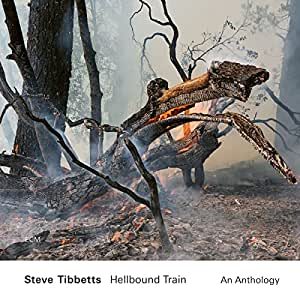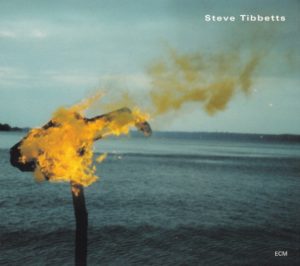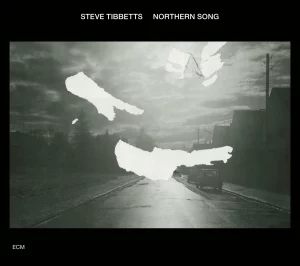Man schaue sich das Cover der Steve Tibbetts-Trilogy „Hellbound Train“ an. Feuer! Für jemanden, der seit 1982 jedes Album von Steve Tibbetts als „soul food“ erfahren hat, stellen diese „visual impacts“ oft raffinierte „klassische“ Konditionierungen der jeweiligen musikalischen Reiz- und Nahrungskette bereit. Viele seiner Cover sind so langlebig wie die Musik. Für jemanden, für den das Meditative und das Exstatische die berühmten zwei Seiten einer Münze sind, sind Cover Einladungen, freundliche Angebote des Verweilens. Das Ungebändigte, das Feuer, „einzufrieren“ in einem Sekundenbruchteil, weist aber auch darauf hin, das wir nicht an einer gemütlichen, anheimelnden Veranstaltung teilnehmen. Die Wildnis lauert überall. (m.e.)
„I have always admired Steve Tibbetts, as a sort of Lone Ranger in the ECM universe, with his singular process of creating his albums in his home studio. I have read how he works slowly, moving a mic an inch and trying once again to get an elusive sound out of his guitar – then trying again and again until it’s right.
His albums are indeed journeys: as he himself says, he doesn’t write traditional song-forms, with jazz changes and tightly written unison lines – all the kinds of things you hear from most guitarists. This lack of a recognizable short form allows for hearing new things each time around.
It’s like putting a space in the room, a 3d sound sculpture you can walk around and examine from all angles. The circular quality of the music places me in a kind of trance state. The fact that Tibbett’s music has its edges of darkness is what gives the music its mystery, and makes it a far deeper dive than if it was merely “pretty.”“
(Brian Whistler on Steve‘s music)
What’s the origin of your interest in drones?
“Tomorrow Never Knows.” When Revolver was released faithful Beatle students played the album incessantly. None of us knew what that sound was that opened up that song, but we knew it was the right thing. When I worked in Nepal and Bali I got used to living in the daily world of Tibetan ritual drones and the cyclical steady-state world of Balinese Gong Kebyar, which is drone-like in its own way. Drones and gong cycles were something new to settle into when I was far away from my studio and music making. (…) Part of the thing that I work with drones is, that they are easy. It is easy to tune two strings on the guitar to a constant fifth or fourth, and play over it – you have your own little accompanyist there, your own little „sarangi“ or „sarod“ droning on behind you, and it makes improvisation and composition easy. It is like making pancakes out of a mix, out of a box. Just add water, and you‘re ready to go. just add drone, and start playing.
The fire never stops. „Right now I’m working on a project with Marc and others. It’s emerging as big, sad, strange, planet-colliding music. Marc is hitting his drums pretty hard, and I’m enjoying the firefight between the Stratocaster and Marshall. The 12-string is happy and resonant. It all sounds good, and the better it sounds, the slower we work. When that project is finished, I’ll move my studio from the building I’ve been in for 36 years to my home. With my children gone I can move a few instruments into the girls’ childhood room and settle into some time with 12-string and piano. I’ll spend time looking out the windows. We live on the edge of a small forest. Visitors include coyotes, turkeys, deer, possums, racoons, and lots of birds.“



